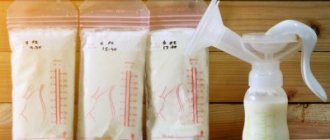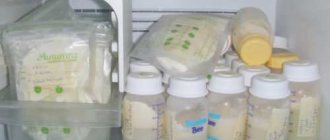Breasts are prohibited.
Breast milk will always be the best food for a baby, but in life there are often situations when a child, for various reasons, is deprived of this necessary product. How to choose the right replacement and correctly transfer your baby to formula? Transferring to mixed or artificial feeding is always stressful for a child. No matter how “tested” or, conversely, modern the formula may be, it still cannot replace mother’s milk for a baby. Fortunately, situations in which it is truly not recommended to breastfeed a child are rare.
On the part of the child, contraindications to breastfeeding are some metabolic diseases (phenylketonuria, galactosemia). On the mother's side - serious illnesses (kidney or heart failure, mental illness, malignant neoplasms) or dangerous infections that can infect the child (HIV infection, hepatitis C, open form of tuberculosis).
Other situations - prescribing certain medications to the mother, detection of staphylococcus in milk, problems with the breast - do not necessarily mean stopping breastfeeding. You can always find a compromise that allows you to undergo treatment and continue to breastfeed your baby.
Not enough milk?
Often, young mothers feel like they don’t have enough milk and the baby isn’t getting enough. It is very simple to check this - carry out a control weighing before and after feeding (preferably several times: the baby should be undressed and without a diaper). If the baby has eaten his physiological norm of milk, we can confidently say that he is full. However, sometimes nursing mothers actually begin to produce less milk than usual. Such periods are called lactase crises. In this case, do not rush to feed the baby with formula, but put him to the breast more often, and then the milk will begin to flow again in the same volume.
SIGNS OF A TRUE MILK SHORTAGE
- A breastfeeding mother does not feel that her breasts are full between feedings.
- Normally, the diaper is changed every 3 hours. If after this time the diaper is dry or slightly swollen, this is a sign that the child’s urination has become less frequent.
- Changes occur with the baby's stool - if the baby usually has stool after each feeding, now this happens less often. In addition, the stool may become denser.
- The child is not gaining weight well.
You can act differently: if a child cries because he is hungry, then he can be supplemented with formula so that he sleeps peacefully. But during this period, the mother necessarily expresses with her hands or with a breast pump after each feeding (even at night!), actually latches the baby often, drinks various teas for nursing mothers, decoctions, and homeopathic remedies. This method is much calmer, and the result is the same.
You should start giving your baby formula only if all means aimed at improving lactation have failed. You need to supplement your baby's feeding only after you have attached him to both mammary glands, even if there is very little milk in them. After this, you can give the child a mixture, starting with 20-30 g per feeding. If there is a need to completely switch to artificial feeding, first replace half of one feeding, then this entire feeding, then another one in the same way, etc. Transferring your baby from breast milk to formula will take you 5-7 days. In the same way, the transition from one mixture to another occurs (but only on the recommendation of the pediatrician).
How to choose the right mixture.
Your pediatrician should prescribe the most suitable formula for your baby. But parents also need to know some criteria for its selection. Thus, up to 6 months, only adapted breast milk substitutes are acceptable for an infant: their composition is as close as possible to human milk and is enriched with all the vitamins and minerals necessary for the baby. In addition, the adapted milk formulas contain nucleotides (biologically active substances that increase the child’s immunity and have a positive effect on the digestion process) and taurine (an amino acid necessary for the proper formation of the child’s brain and visual analyzer). Most formulas are divided into initial ones - for children from 0 to 3 months (Humana PR), from 3 months - Humana 1, from 6 months - Humana 2, Humana 3 - from 10 months, also the new Humana Junior - from 12 months . All initial mixtures are adapted. The difference between subsequent mixtures is that they have a higher energy value - they have an increased content of protein, iron and other important nutrients. A number of mixtures that contain an average amount of all nutrients necessary for a child in the first year of life can be called universal. They can be used to feed children from birth to 1 year (the packaging says “0-12 months”).
Is night feeding necessary for a child over one year old?
Mothers, deciding to stop breastfeeding, doubt whether the child will be able not to eat all night and whether he has a physiological need for food. Experts have a unanimous opinion - after a year, the baby can completely do without night feedings if he eats fully during the day. However, for every rule there is an exception. To accurately answer the question of whether it is worth continuing to feed at night after a year, you need to know what kind of nutrition the child is on.
Breast-feeding
Breastfed children begin to latch on to the breast more often at the age of one year. This trend is not always perceived correctly by mothers. Many parents believe that the baby is growing, so he needs more night feedings. Actually this is not true.
After a year, the baby can sleep throughout the night and not ask to suckle. Awakenings happen out of habit. The baby knows that he can calm down at his mother’s breast and fall asleep sweetly, so he asks for the breast. If a woman refuses breastfeeding, the baby will not be deprived. It is important to continue to maintain physical contact with the baby, and to curtail lactation without the baby’s psycho-emotional discomfort.
You should not replace night breastfeeding with formula after a year. However, it is recommended to offer your child a milk drink during the day. The adapted formula for children after one year includes vitamins and microelements, beneficial amino acids and proteins.
Artificial feeding
When bottle-feeding, most pediatricians strongly recommend eliminating night feedings. At this age, the baby’s digestive tract works in the same way as an adult: it takes in and digests food during the day, and needs rest at night.
Breast milk is completely absorbed by the baby's body and is considered a light food. This cannot be said about adapted formulas for children after one year. If a child wakes up, it’s just a habit. You can hear from many mothers that the baby becomes more restless after feeding and begins to ask for formula more often. The fact is that the digestive system is “resting”, so the mixture cannot be absorbed correctly and causes bloating in the baby.
When winding down night feedings during artificial and natural feeding, you can replace them with water or give them a pacifier. It is not recommended to offer juices, compotes, fruit drinks and other drinks containing sugar. They negatively affect the condition of the baby's teeth.
Features of feeding.
One of the most common questions on forums is whether to supplement a bottle-fed baby with water. Modern doctors believe that when feeding a child with adapted formulas, there is no need to give him additional water. But if you feel that the baby is thirsty, then you can start offering water from 3-4 weeks in between feedings, 20-30 ml. In bottle-fed children, stools are thinner and more shaped than in infants. Artificial babies may experience fewer problems due to colic than infants, since in their case there is no dependence on what the mother eats. However, on the other hand, colic in infants may be caused by improper dilution of the formula, as well as by swallowing air when the bottle is placed incorrectly during feeding. In the future, the daily amount of food for children under 1 year of age is calculated taking into account their body weight at a certain age. For children aged 10 days to two months, the daily amount of food should be 1/5 of body weight (on average 600-900 ml). For example, 4000 g : 5 = 800 g per day. For children from 2 to 4 months -1/6 body weight (800-1000 ml). For children from 4 to 6 months - 1/7 body weight (900-1000 ml). For children from 6 months to 1 year - 1/8-1/9 body weight (900-1100 ml). The daily volume must be divided by the number of feedings, and then you will get the amount of food that the child should eat in one feeding. In the first months of life, the baby needs to be fed 6-7 times a day - every 3-3.5 hours with a 6-hour night break. After you start introducing complementary foods, the child is transferred to 5 meals a day (every 4 hours).
How to replace breast milk?
Often milk disappears simply because mothers do not want to breastfeed for a long time...
Everyone knows that the best food for a baby is mother's milk. But, unfortunately, not everyone is able to feed themselves. How to choose the right substitute and what are they? Our expert, pediatrician Marina KONDRATIEVA, tells us
“My friend Masha’s son eats this mixture well. We need to take it too...” This is often how mothers choose food for their babies. Often the price of such experiments is intestinal problems and red cheeks from allergies.
Any nutrition must be prescribed by a pediatrician. Do not immediately switch your child to formula if it seems that you have not enough milk, and do not buy a jar that was simply recommended to you in the store. The baby’s body cannot easily tolerate a change in diet. There are several types of substitutes precisely because all children are different.
Choosing a mixture
Hypoallergenic preventive (whey protein hydrolysates).
Unfortunately, children are often allergic to cow's milk protein. In hydrolysates, cow's milk proteins have already been broken down and are not dangerous. Otherwise, these mixtures contain everything a growing organism needs.
ATTENTION! All hydrolysates cause changes in baby's stool - it can become green and runny. Don't be alarmed, this is normal. Hypoallergenic mixtures have a bitter taste.
Goat milk mixtures.
Goat milk has always been considered low-allergenic and very healthy. For many children who cannot tolerate cow's milk, goat's milk formula is just a lifesaver. Unfortunately, allergies are often cross-allergic - to both cow and goat. So allergy sufferers should administer the mixture very carefully.
Soy.
If a child cannot tolerate either cow's or goat's milk, soy proteins are the last hope. They rarely cause allergies.
Low-lactose and lactose-free.
In order to digest the main component of any milk - lactose (milk sugar), the body has a special enzyme - lactose. If this enzyme is not enough, lactose deficiency occurs - difficulty digesting milk. Such children have a stomach ache all the time, they are tormented by gases, and frequent and loose stools. In such a situation, mixtures without or with low lactose content can help out. Or - soy mixtures and hydrolysates. They are also lactose free.
The main thing is that lactose-free formulas should not be given to a child for a long time, because lactose helps the absorption of vitamins and is necessary for the intestinal microflora.
IMPORTANT!
A good mixture should contain prebiotics and nucleotides. Prebiotics are healthy carbohydrates that improve the composition of intestinal microflora, stimulate the proliferation of bifidobacteria, relieve constipation and make the child’s stool soft. Nucleotides also help get rid of intestinal problems and develop the baby’s immune system.
It's better to return the breasts!
Only 20 - 30 percent of mothers continue to breastfeed for longer than 3 months. But only 3 percent of women actually lose milk (due to hormonal imbalance). For the rest, lactation ends due to improper latching of the baby to the breast, feedings not according to the schedule, due to supplementing the baby with water, early introduction of complementary foods, refusal of night feedings and, of course, due to feeding with formulas when there is no need for this. And milk often disappears simply because the mother does not want to breastfeed for a long time.
TEST
If the food is not suitable...
After formula feeding (answer yes or no):
Are your child's cheeks red? Has a red rash appeared on the body and in the folds of the skin? Does your baby turn away from the bottle and cry after feeding? Does your child vomit after eating? Does he suffer from diarrhea or constipation? Has he started burping more often?
If you answered yes to at least one question, the formula your baby is currently eating is clearly not suitable for him.
ON A NOTE
Don’t overfeed with kefir...
1. To warm the mixture to the temperature of mother's milk (37 degrees), do not put the bottle in the microwave - there the food will lose many of its beneficial properties. Buy a warmer or place the bottle in warm water before feeding.
2. Kefir should make up no more than 30 percent of the total daily food; too much fermented milk can increase regurgitation.
3. Dilute the mixtures strictly according to the instructions. Because of the desire to make you “fat,” you can “give” your child kidney problems.
4. Prepare food immediately before feeding or place a bottle of formula in the refrigerator in advance. If the baby has not finished the milk, the remaining formula cannot be used.
5. The eternal problem of bottle-fed children is constipation. Be sure to give your kids water. Up to 3 months - 100 ml per day, from 3 to 6 months - 150 ml. Many mixtures are good for constipation (for example, those containing carob gluten or starch), but only in combination with water. Offer your child a drink 30 minutes before or an hour after meals.
6. Don't overfeed! Here's a formula to easily calculate your serving size:
from 10 days to 2 months - divide the child’s weight by 5. The resulting figure is the daily requirement of your baby in milliliters;
from 2 to 4 months - divide the weight by 6. From 4 to 6 months - by 7. From 6 to 9 months - by 8.
It is better to feed artificial animals on a schedule:
up to 1 month - when asked, but up to 10 times a day; 1 - 3 months - about 7 times; 3 - 4 months - about 6 times; from 4 months to a year - about 5 times a day.
If it doesn’t work out according to the schedule, don’t starve your child and look at the clock, feed more often, but little by little.
We are waiting for your letters at
Prepare the mixture.
Diluting the mixture is not at all difficult, but you need to follow a few rules. Wash your hands thoroughly before preparing the mixture. Take a sterilized bottle and fill it with hot (50-60 degrees) boiled water. An option is possible when you use special baby water, which does not need to be boiled. Then the mixture is poured into water at room temperature and then heated. This is done much more often. Using a measuring spoon, add the required amount of dry mixture and mix. Do not try to pour the powder into a heaped spoon to increase nutritional value - this can lead to digestive disorders in the baby (excessive regurgitation, vomiting, stool instability, allergies). The temperature of the finished mixture should correspond to the temperature of breast milk, that is, approximately 36-37 degrees. This can be checked by dropping a few drops of the mixture on your wrist (you should not feel any heat or cold). It is better to give a colder mixture than a hotter one. If your baby does not eat all the prepared mixture, do not leave the leftovers until next time. Before each feeding, dilute a fresh portion of the mixture. Also, the mixture cannot be prepared in advance (for example, overnight). The maximum storage time for the prepared mixture in the refrigerator is 2 hours. Wash the bottle after each feeding with hot water and baking soda or baby dish soap. For children in the first weeks of life, pacifiers and utensils must be placed in a sterilizer at least once a day. It happens that with the transition to artificial feeding, a mother is tempted to completely entrust the process of feeding and caring for the child to someone else (nanny or grandmother). Even if you work and cannot be with your child all the time, try to devote the time when you are at home to the baby. Both the baby and you need this communication.
Why is GW questionable today?
Breast milk does not need to defend its primacy, because... Behind him is Nature itself - a long time of evolutionary processes that cannot in any way be unjustified. But in modern realities the situation is completely different and justice has to be restored more and more often. Current society has practically lost the continuity of generations; the experience of breastfeeding is now rarely passed on from mother to daughter and from grandmother to granddaughter. And it is quite a common occurrence among modern girls to never see the process of breastfeeding a baby live in their lives. Therefore, a woman’s decision about whether or not to breastfeed her child is formed, largely, under the influence of commercial information from leaflets, booklets and other advertising from manufacturers of formula and accessories for artificial feeding. Yes, even toy babies in a children's store are equipped with a neat bottle, a nipple and a suitable hole in their mouth. What idea do girls have of feeding a baby from childhood?
All over the world, aggressive advertising by manufacturers of artificial nutrition for newborns is being fought. In 1981, the World Health Organization adopted the International Code of Marketing of GM Substitutes. This code of practice was developed to limit the advertising of artificial breast milk substitutes so as not to undermine women's intention to breastfeed. In addition to restrictions on the advertising of formula, the code of practice addresses the ethical aspects of advertising bottles and pacifiers. But, obviously, not all countries adhere to these rules.
Unfortunately, many do not know that the emergence of seemingly insurmountable difficulties is not a reason to stop feeding.
If you're having trouble or don't like breastfeeding, get help! Breastfeeding is too important to give up without thought or effort! Most likely, they will be able to help you and provide support at this difficult moment.
How to understand that the formula is not suitable for the child?
Regardless of whether you breastfeed or bottle feed your baby, at these moments the baby still feels the closeness of his mother. And well-chosen bottles and nipples will allow you to properly organize the feeding process. When choosing products to feed and care for your baby, safety, quality and convenience are critical. Make sure that all bottles and teats you choose meet international quality standards. Remember that the most important thing for your baby and his health is your love and care.











